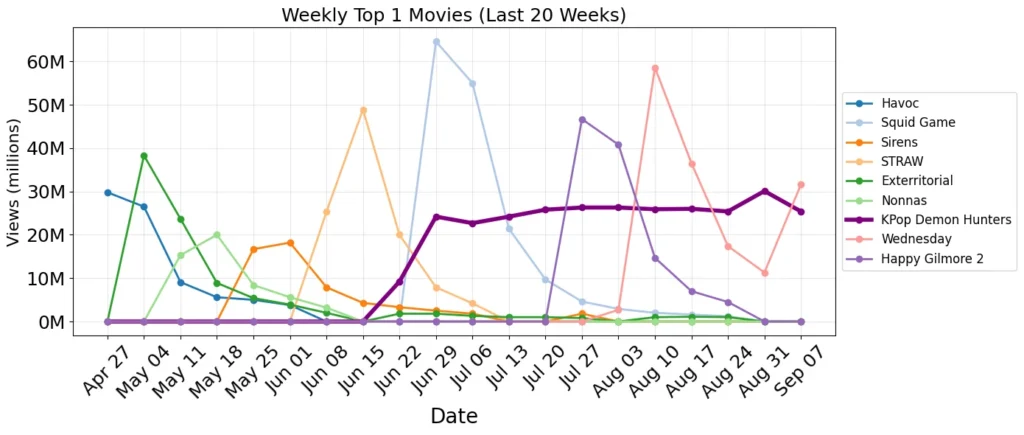A Korean animated movie, K-Pop Demon Hunters, KPDH, just broke all-time record for most watched movie in the History of Netflix. It’s only 92 days old, and not a big-budget film with massive marketing, but it’s had over 314 million views so far, appearing on the most-watched list in 32 countries. Some Chinese movies have had more views, but these tend to be specific to China, with limited appeal elsewhere. KPDH has three songs in the Billboard 100 too, including golden at no.1, see official music video, 352M views for the music video. The last movie to have three songs in the Billboard top 100 was Saturday Night Fever, some 45 years ago. Other top Korean groups include Stray Kids, BTS, and Black Pink, they’ve had multiple #1 songs world wide of the last five years, and fill 50,000 seat stadiums regularly with seats going for $150. Here are Black Pink, filling a 50,000 seat stadium in Paris. If you read the US press, you’d hardly know these groups exist. BTS had a big hit during Covid called, “Permission to Dance,” a positive song during that grim period, danced e.g at the UN. Listeners noticed, the press did not. I think the press finds Koreans “anodyne”, that is, insipid.

One thing that turns off the US press, is that Korean songsters and movies are less sexual, and less politically moralizing. The top Oscar awards go to political movies. At the Emmies, this year, we were told, “F*ck ICE, Free Palestine.” Similarly, Green Day, Eminem, and other western bands lead chants of F*ck Trump. The press takes this moralizing as intellectual, but I find it cheap and suspect it turns off many potential fans.
A favorite moralizing of US movies is to show women who don’t need or want men. Frozen was like that, as was Encanto, Last Dragon, Moana… Star Wars was a top franchise that Disney made more feminist, writing basically every man as bad. Women were good, powerful, and inherently talented. Rey a main new character, grabs a light saber with no background or training, and uses it like an expert. It turns off men, then women stayed away too.
We like to show black actors in white rolls too, though not white actors in black rolls. Hamilton was successful, and had black actors playing in every positive roll, white actors playing evil idiots. It was done again with 1776, less successfully. All the founding fathers are cast as women; Jefferson is black, bisexual, and pregnant. There’s a message somewhere. The upcoming movie about King Gustaf of Sweden has a dark-skinned actor playing the king. Why? We had a dark- skinned daughter of the major general, who bends the pirate over to kiss him, a dark skinned Snow White with most of the Dwarves normal height, a female She-Hulk, stronger than the original, who lectures the original (and us) about anger. Apparently, the idea is to highlight the difficulties powerful women face. Korean shows have casts that make sense to the plot, and no gratuitous reversals or sex. Did Oppenheimer need the many sex scenes? Did the suicidal love interest have to be written stronger than the main character?
Then there are the sequels: the Marvel universe includes 37 interconnected movies, Star Wars, 19, Batman 13. To get the full story, you have to see them all. So far, in 2025, only two of the major funded movies were original (one was Korean, Mikey 17). The others are all reboots or sequels with recycled plots and ever-bigger explosions. It all works until it doesn’t, then they make a reboot. Law and Order, 26 years old with 500 episodes.
Korean entertainment has series too, but much shorter and with fewer explosions. A TV series will have only 16-24 episodes and I’ve yet to see one with a mass-murderer. The Squid game, has had 13 episodes over 3 seasons. Some deaths, but not wholesale. A longer series, “Crash Landing on You,” 24. In it, a successful South Korean executive (female) is blown across the border to North Korea into the arms of a handsome, North Korean. No deaths. They could have gone on for years, but didn’t. People rewatch the original.
Other countries movies moralize too, like ours do, but they tend to be patriotic moralization, and anti gratuitous violence, not violent, anti-patriotic as in the US. Chinese TV shows present Chinese politicians as honest, they have praise for the Chinese schools and infrastructure, and regular invocations to respect the police. India moralization is similar, but more towards family order. Korean messages are in-between, with some crooked politicians, some violence, people with mental or emotional problems who evolve.
Robert Buxbaum, September 17, 2025. The industry has pushed back against criticism of their wokeness, claiming that the only folks turned off are the toxic fans: white, MAGA men, mostly, who hate diversity. They claim to be happy when such fans stay home and watch KPDH, or go buy $150 tickets to see Koreans sing in Korean.







